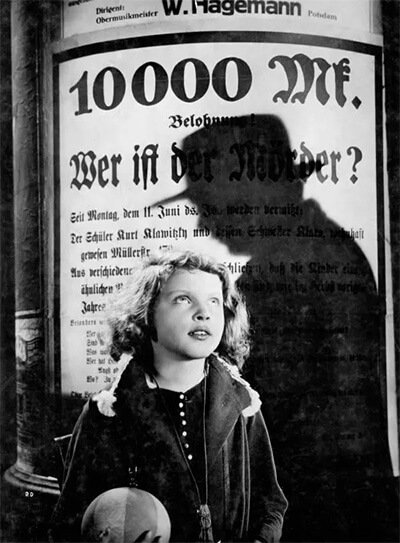As you get deeper into M, you appreciate with each passing scene how its themes are painfully relevant today, nearly a century later. The grainy black and white cinematography and the stagey acting by supporting players remind you it’s a product of another time and another place. But the ideas it tackles are still debated today.
It’s Berlin, in a working class neighborhood. The dark mood begins immediately as we hear children playing in a courtyard. One little girl is singing:
Just you wait, it won’t be long.
The man in black will soon be here.
With his cleaver’s blade so true,
He’ll make mincemeat out of you!

On the streets, little Elsie is leaving school. She stops in front of a poster warning about the disappearance of neighborhood children. And on the poster … the shadow of a man in silhouette. A classic image. It’s chilling.
This stranger is whistling the universally recognizable – and foreboding – Edvard Grieg melody, “In the Hall of the Mountain King,” from a play about menacing trolls who capture a young boy. The man befriends Elsie and even buys her a balloon. Elsie does not come home for dinner. Later we see the balloon being borne aloft, symbolically, on the wind.
It’s not the first child disappearance. It’s clear to the police and the neighborhood a serial killer is on the prowl. But just as in the modern serial killer drama, Zodiac, the police are flooded with an overwhelming number of spurious tips. The murderer begins taunting the authorities with letters to the newspaper.
In a deftly edited and mildly farcical set of scenes, director Friz Lang cuts between two private meetings in smoke-filled rooms. In one, the police heads are debating next steps. In the other, local crime lords are lamenting how the police crackdown is stifling their business. The police debate starts with the knee-jerk ideas: more raids of seedy establishments, more searches of apartments. The crime bosses have nothing but contempt for the police raids, which are cutting into their business and getting the police no closer to catching the culprit.
The police strategy eventually lands on scouring the records of hospitals and asylums for anyone released in the past five years who was treated for deviant behavior but was released, having been judged no longer a threat to society. The crime lords come to their own conclusion. They’ll have to get the police off their backs by capturing the fiend themselves. Interestingly, the syndicates are as disciplined and organized in deploying their watchers as the police are in making assignments to scour hospitals.
The race is on. Will the killer be caught? If so, who will reach him first?
See It
Both sides begin to close in on the predator, culminating in a tense nighttime search through a high-rise office building. Peter Lorre is absolutely stunning as Hans Beckert, the man who is finally revealed to be the child murderer. As he tries to elude his pursuers, you sense his growing desperation and frustration.
Peter Lorre began his acting career on the stage, mostly in comedic parts. M was only his second credited film appearance and his first starring role. He was in his mid-20s during filming, thinner and paler than the villains he was later destined to play in movies like Casablanca. Lorre gives one of film’s most notable performances. He is by turns quiet and circumspect, almost seemingly naïve, then sinister and foreboding. During his final speech, which is a masterpiece of emotional surrender, you’re shocked when you realize you’re almost tempted to feel sympathy for this broken thing.
The “talkies” were new in 1931. Some techniques that we take for granted were first introduced by Lang in M. In particular, the leitmotif – a recurring musical theme that accompanies, in this case, a particular character. When we hear “In the Hall of the Mountain King,” or musical notes that evoke it, we know that the killer is about, even if we can’t see him. Think: Darth Vader’s theme in the Star Wars movies. The first talkies filled the soundtrack with dialog, but Lang introduced more organic sound and especially noises and voices from offscreen, giving the action dimension and making M feel more modern than others movies of the time.
And what of that title, M? It’s a clever bit of tagging conceived by one of the criminal pursuers. (I couldn’t help but be reminded to The Scarlet Letter.)
M also has thematic elements that feel universally relevant. Early on as police officials discuss the challenges of getting the public to assist in the search, one of them observes:
Most of the public still takes the position, “How does this concern me?” The idea that each individual is responsible for what happens to the poorest, most anonymous child on the street hasn’t even dawned on the public at large!
And then of course there are the concluding scenes, which will strike you as controversial and provocative now as they were to German audiences in 1931. Director Lang entangles you in a conversation about the difference between justice and retribution. The ending made me uncomfortable. As it should.
